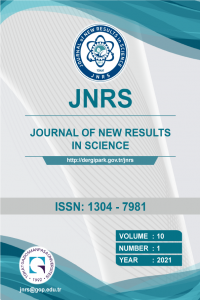Chemical Composition of Essential Oil from Rosmarinus Officinalis L. Leaves
-,
___
- Fahim, F.A.; Esmat, A.Y.; Fadel, H.M.; Hassan, K.F.S., Allied studies on the effect of Rosmarinus officinalis L-on experimental hepatotoxicity and mutagenesis. International Journal of Food Sciences and Nutrition, 1999, 50, (6), 413-427.
- Bernardes, W.A.; Lucarini, R.; Tozatti, M.G.; Souza, M.G.M.; Silva, M.L.A.; da Silva, A.A.; Martins, C.H.G.; Crotti, A.E.M.; Pauletti, P.M.; Groppo, M.; Cunha, W.R., Antimicrobial Activity of Rosmarinus officinalis against Oral Pathogens: Relevance of Carnosic Acid and Carnosol. Chemistry & Biodiversity, 2010, 7, (7), 1835-1840.
- Machado, D.G.; Cunha, M.P.; Neis, V.B.; Balen, G.O.; Colla, A.; Bettio, L.E.B.; Oliveira, A.; Pazini, F.L.; Dalmarco, J.B.; Simionatto, E.L.; Pizzolatti, M.G.; Rodrigues, A.L.S., Antidepressant-like effects of fractions, essential oil, carnosol and betulinic acid isolated from Rosmarinus officinalis L. Food Chemistry, 2013, 136, (2), 999-1005.
- Lucarini, R.; Bernardes, W.A.; Ferreira, D.S.; Tozatti, M.G.; Furtado, R.; Bastos, J.K.; Pauletti, P.M.; Januario, A.H.; Silva, M.L.A.E.; Cunha, W.R., In vivo analgesic and anti-inflammatory activities of Rosmarinus officinalis aqueous extracts, rosmarinic acid and its acetyl ester derivative. Pharmaceutical Biology, 2013, 51, (9), 1087-1090.
- Ma, C.H.; Song, K.G.; Yu, J.H.; Yang, L.; Zhao, C.J.; Wang, W.J.; Zu, G.; Zu, Y.G., Pyrolysis process and antioxidant activity of pyroligneous acid from Rosmarinus officinalis leaves. Journal of Analytical and Applied Pyrolysis, 2013, 104, 38-47.
- Wang, H.; Liu, F.; Yang, L.; Zu, Y.G.; Wang, H.; Qu, S.Z.; Zhang, Y., Oxidative stability of fish oil supplemented with carnosic acid compared with synthetic antioxidants during long-term storage. Food Chemistry, 2011, 128, (1), 93-99.
- Munoz-Munoz, J.L.; Garcia-Molina, F.; Ros, E.; Tudela, J.; Garcia-Canovas, F.; Rodriguez-Lopez, J.N., Prooxidant and Antioxidant Activities of Rosmarinic Acid. Journal of Food Biochemistry, 2013, 37, (4), 396-408.
- Bakkali, F.; Averbeck, S.; Averbeck, D.; Waomar, M., Biological effects of essential oils - A review. Food and Chemical Toxicology, 2008, 46, (2), 446-475.
- Laybourne, G.; Moss, M.; Wesnes, K.; Scott, S.D., Effects of acute oral administration of rosemary and peppermint on cognition and mood in healthy adults. Journal of Psychopharmacology, 2003, 17, (3), A62-A62.
- Erenmemisoglu, A., Effect of a Rosmarinus officinalis leave extract on plasma glucose levels in normoglycaemic and diabetic mice. Pharmazie, 1997, 52, (8), 645-646.
- Moss, M.; Cook, J.; Wesnes, K.; Duckett, P., Aromas of rosemary and lavender essential oils differentially affect cognition and mood in healthy adults. International Journal of Neuroscience, 2003, 113, (1), 15-38.
- Tigrine-Kordjani, N.; Chemat, F.; Meklati, B.Y.; Tuduri, L.; Giraudel, J.L.; Montury, M., Relative characterization of rosemary samples according to their geographical origins using microwave-accelerated distillation, solid-phase microextraction and Kohonen self-organizing maps. Analytical and Bioanalytical Chemistry, 2007, 389, (2), 631-641.
- Tounekti, T.; Vadel, A.M.; Onate, M.; Khemira, H.; Munne-Bosch, S., Salt-induced oxidative stress in rosemary plants: Damage or protection? Environmental and Experimental Botany, 2011, 71, (2), 298-305.
- Yosr, Z.; Hnia, C.; Rim, T.; Mohamed, B., Changes in essential oil composition and phenolic fraction in Rosmarinus officinalis L. var. typicus Batt. organs during growth and incidence on the antioxidant activity. Industrial Crops and Products, 2013, 43, 412- 419.
- Jordan, M.J.; Lax, V.; Rota, M.C.; Loran, S.; Sotomayor, J.A., Effect of bioclimatic area on the essential oil composition and antibacterial activity of Rosmarinus officinalis L. Food Control, 2013, 30, (2), 463-468.
- Yesil-Celiktas, O.; Kocabas, E.E.H.; Bedir, E.; Sukan, F.V.; Ozek, T.; Baser, K.H.C., Antimicrobial activities of methanol extracts and essential oils of Rosmarinus officinalis, depending on location and seasonal variations. Food Chemistry, 2007, 100, (2), 553-559.
- Singh, M.; Guleria, N., Influence of harvesting stage and inorganic and organic fertilizers on yield and oil composition of rosemary (Rosmarinus officinalis L.) in a semi-arid tropical climate. Industrial Crops and Products, 2013, 42, 37-40.
- Greiner, J.F.W.; Muller, J.; Zeuner, M.T.; Hauser, S.; Seidel, T.; Klenke, C.; Grunwald, L.M.; Schomann, T.; Widera, D.; Sudhoff, H.; Kaltschmidt, B.; Kaltschmidt, C., 1,8- Cineol inhibits nuclear translocation of NF-kappa B p65 and NF-kappa B-dependent transcriptional activity. Bba-Mol Cell Res, 2013, 1833, (12), 2866-2878.
- Santos, F.A.; Rao, V.S.N., Antiinflammatory and antinociceptive effects of 1,8-cineole a terpenoid oxide present in many plant essential oils. Phytother Res, 2000, 14, (4), 240-244.
- Yuan, G.F.; Wahlqvist, M.L.; He, G.Q.; Yang, M.; Li, D., Natural products and anti- inflammatory activity. Asia Pac J Clin Nutr, 2006, 15, (2), 143-152.
- Santos, F.A.; Rao, V.S.N., 1,8-cineol, a food flavoring agent, prevents ethanol-induced gastric injury in rats. Digest Dis Sci, 2001, 46, (2), 331-337.
- Smeti, S.; Atti, N.; Mahouachi, M.; Munoz, F., Use of dietary rosemary (Rosmarinus officinalis L.) essential oils to increase the shelf life of Barbarine light lamb meat. Small Ruminant Res, 2013, 113, (2-3), 340-345.
- Badawy, M.E.I.; Abdelgaleil, S.A.M., Composition and antimicrobial activity of essential oils isolated from Egyptian plants against plant pathogenic bacteria and fungi. Ind Crop Prod, 2014, 52, 776-782.
- Canale, A.; Benelli, G.; Conti, B.; Lenzi, G.; Flamini, G.; Francini, A.; Cioni, P.L., Ingestion toxicity of three Lamiaceae essential oils incorporated in protein baits against the olive fruit fly, Bactrocera oleae (Rossi) (Diptera Tephritidae). Nat Prod Res, 2013, 27, (22), 2091-2099.
- ISSN: 1304-7981
- Yayın Aralığı: 3
- Başlangıç: 2012
- Yayıncı: TOKAT GAZİOSMANPAŞA ÜNİVERSİTESİ
Necla Türkmen, Ayşenur Öz, Aslı Sönmez, Tuğçe Erol, Deniz Gülümser, Burcu Yurdakul, Ömer Kayır, Mahfuz Elmastas, Ramazan Erenler
Osama A. E. Tantawy, Sobhy A.El-Sheikh, Rasha N.Majeed
Burcu Bayir, Hatice Gündüz, Tuba Usta, Esma Şahin, Zeynep Özdemir, Ömer Kayır, Özkan Sen, Hüseyin Akşit, Mahfuz Elmastaş, Ramazan Erenler
